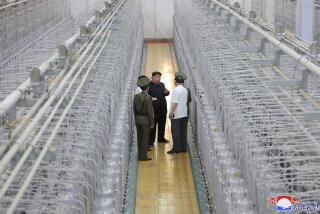North Korea’s Use of Chemical Torture Alleged
- Share via
SEOUL — A senior North Korean chemist who defected to the South two years ago says he witnessed the government testing chemical weapons on political prisoners.
Although the chemist’s information is dated -- he says he saw one experiment personally in 1979 and heard about others until the mid-1990s -- his statements mark the first time a high-level scientist from North Korea has spoken out about human experimentation.
Similar allegations have been made before. Last month, papers said to have been smuggled out of North Korea appeared to show that prisoners were sent to a chemical complex for gas experiments in 2002. But many of the prior reports had been made by former political prisoners and guards whose credibility has been questioned.
The chemist said fear of retribution against family members still in North Korea had kept him from speaking out until now but he decided to break his silence because of the need for the world to know. He asked that his name not be published.
“It is not easy for me to speak about this because I am a criminal myself,” said the chemist, a man in his 50s, at the beginning of a halting and emotional three-hour interview last week that was arranged by a U.S.-based human rights group.
The chemist said the experiment he witnessed took place at a military prison near Pyongsong, 15 miles north of the capital, Pyongyang. At the time, he was a PhD candidate. He was invited to witness the experiment because his dissertation involved the chemical compounds being tested -- cyanide and ortho-nitrochlorobenzene.
The chemist said that the prison was known to house political prisoners. He said that they were kept in stacked cages made of concrete and wire “like rabbit hutches.” The two men in the experiment, he said, were unshaven and emaciated and “they looked barely human.” They were brought to the chamber in wheelchairs, he said. He could not determine their ages.
The chemist said the men were tested separately in a chamber with a large window on one side -- where scientists and officials observed. It was outfitted with bright lights, a speaker system that allowed the scientists to clearly hear the prisoners’ screams and a nozzle to spray the chemicals.
“One man was scratching desperately. He scratched his neck, his chest. He was wearing a gray prison uniform, and he tore it off. He was covered in blood.... I tried to look away,” said the chemist, who said he watched with other researchers from behind the glass. “I kept trying to look away. I knew how toxic these chemicals were in even small doses.”
It took three hours for each man to die, the chemist said.
“It was horrible. They were screaming and yelling.... They seemed to develop some superhuman strength before they died. I kept thinking: It is not so simple to kill a human being after all,” he said, his voice cracking. “This is not something you want to remember.”
After the men were dead, guards in gas masks and full body suits pulled the prisoners into an uncontaminated compartment of the chamber to examine them.
North Korea denied as recently as last month that it had gassed prisoners, and it is impossible to confirm the chemist’s account of the human experimentation. Other defectors have been known to exaggerate North Korean atrocities for money or to win asylum for their families. But several people active in the human rights field said they found the chemist and his story believable.
Seoul-based human rights investigator Kim Sang Hun said that so far, the chemist is the most credible witness on the issue of human experimentation.
“What he saw happened a long time ago, but he is a very senior scientist, and he is the first to describe human experimentation. We are hoping that more witnesses will have the courage to come forward and speak out,” Kim said.
Jae-Joong Nam, president of the Aegis Foundation, a human rights organization based in Ashburn, Va., that arranged the interview, said: “He is a very credible person. He has a PhD. He was a respected scientist. His story is very consistent.”
South Korea’s Unification Ministry, which oversees North Korean defectors living here, confirmed that the chemist was a senior official at a research laboratory in Hamhung, an industrial city on North Korea’s east coast well-known for its chemical factories.
After receiving his PhD, the chemist worked mainly on civilian research. But he said he learned, through a colleague, of human experimentation for chemical weapons taking place through at least 1994, when a famine plunged North Korea into chaos.
The U.S. State Department, in its annual report on human rights released last week, estimated that 150,000 to 200,000 North Koreans were held in prison camps where “conditions are extremely harsh and prisoners are not expected to live.”
Over the weekend, a Japanese TV station aired what it said was the first video footage of a North Korean labor camp to be seen abroad. At Yodok 15, near the Chinese border, prisoners in gray uniforms were shown carrying buckets hung from poles on their shoulders; the buckets were said to contain human excrement. In another scene, women were shown furtively eating cabbage leaves in a field.
More to Read
Sign up for Essential California
The most important California stories and recommendations in your inbox every morning.
You may occasionally receive promotional content from the Los Angeles Times.










